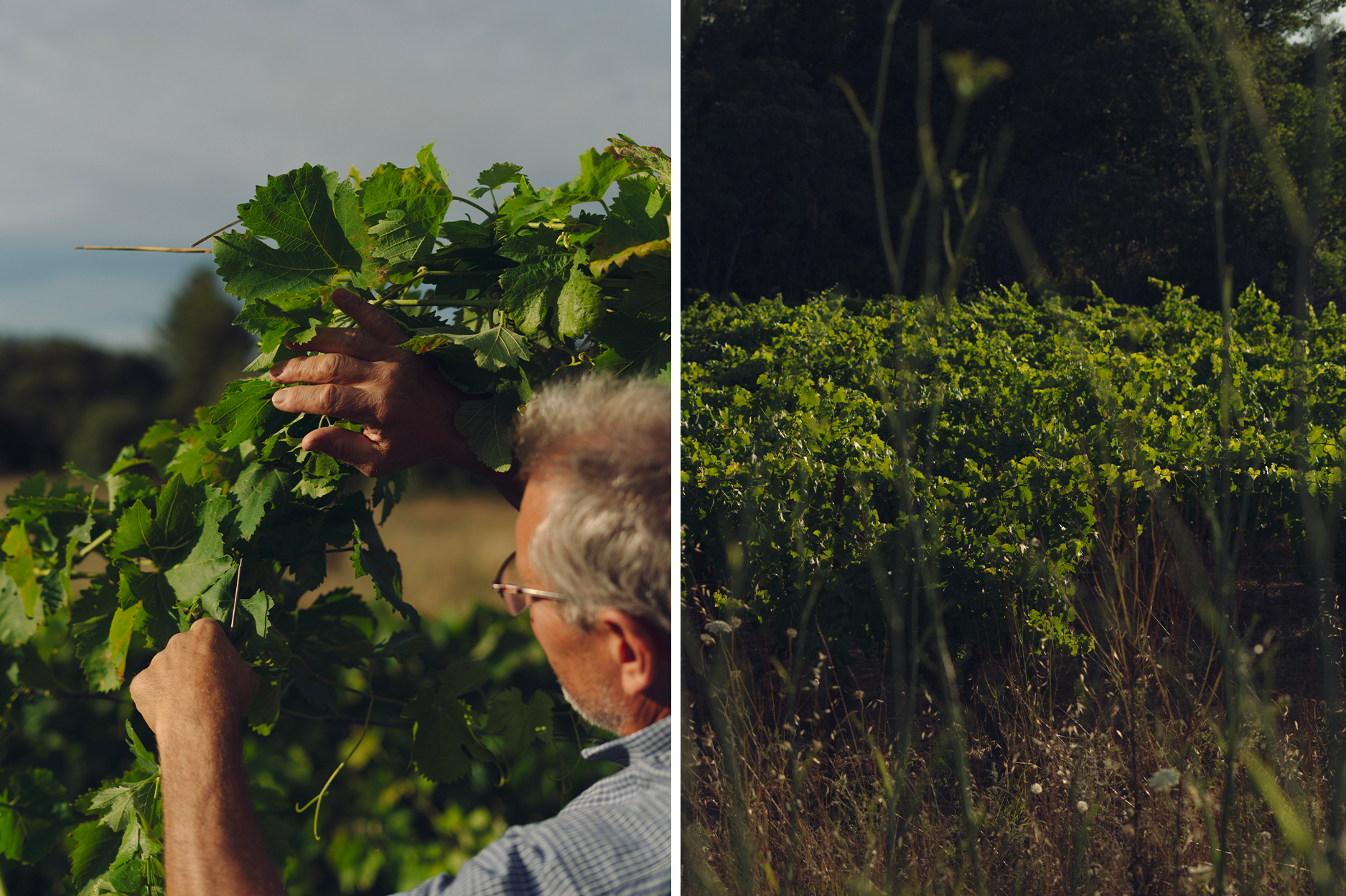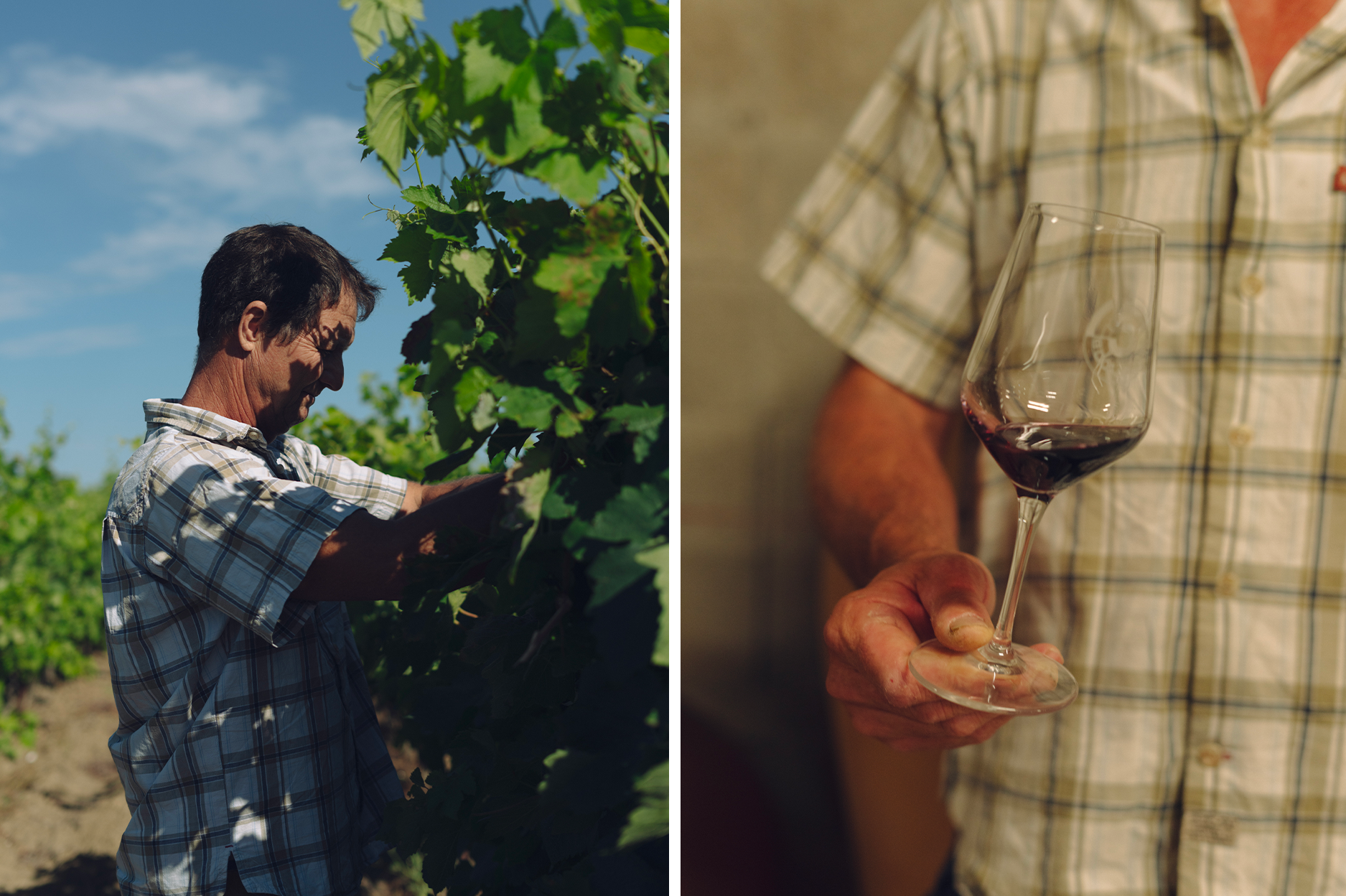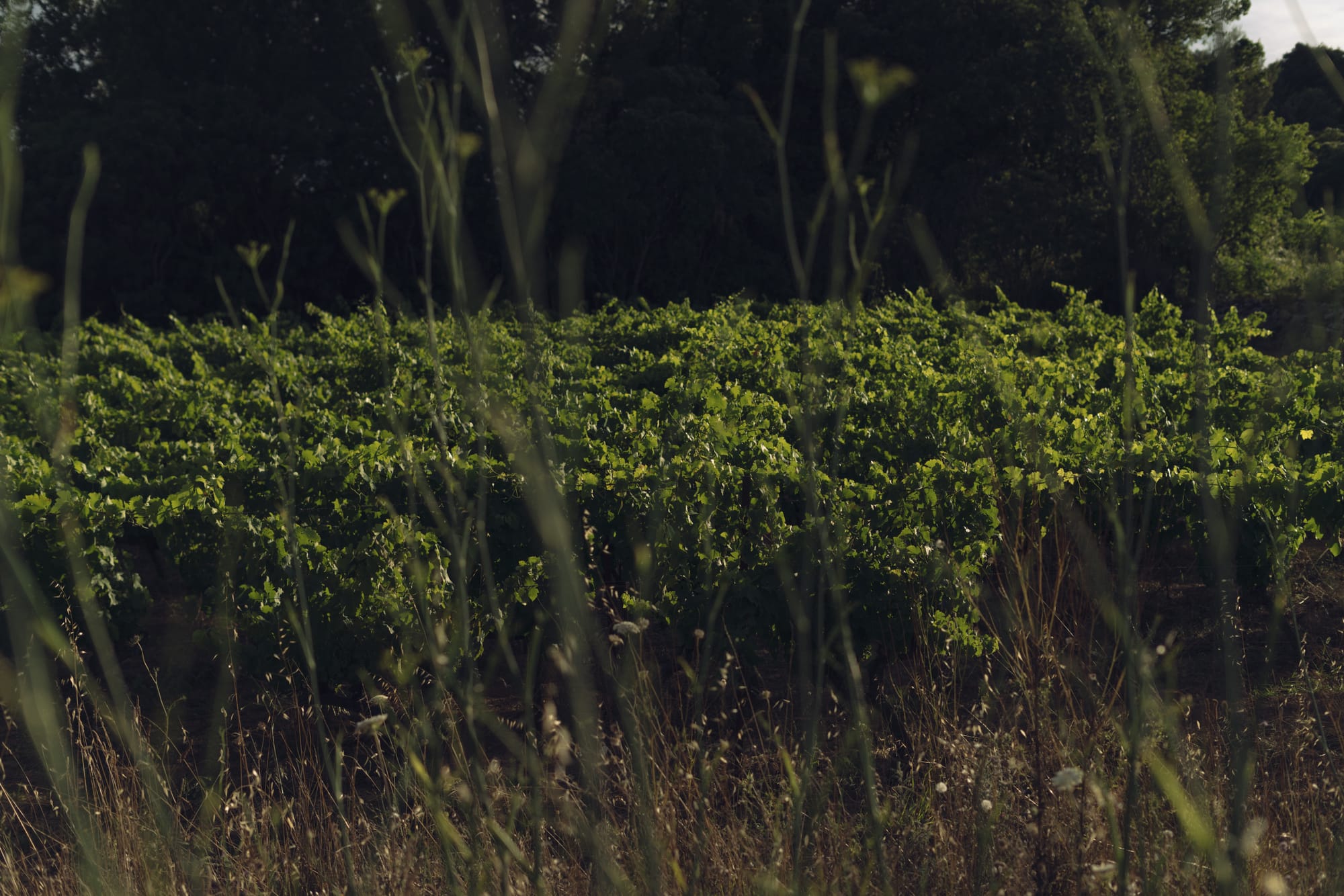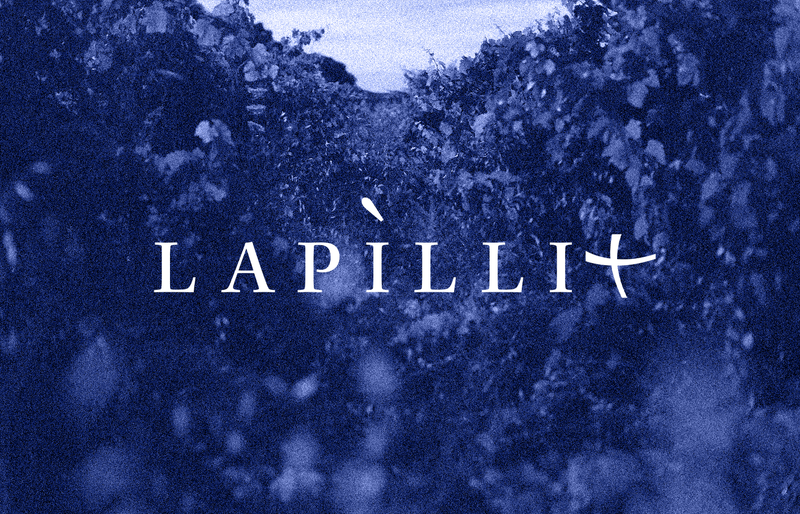Murviel-lès-Montpellier has a long history of viticulture, dating back to Roman times. The limestone-rich soil of this southern French town has earned it national and international recognition for wine production. However, over the past decade, alternating dry periods and intense rainfall have increasingly threatened the taste, quantity and alcohol content of Languedoc’s renowned wines. For this reason, in 2012 the National Institute for Research on Agriculture, Food and Environment (INRAE) included this area in a thorough, ten-year study on the impacts of climate change on the French wine industry.
This month's newsletter, written by journalist Soledad Dominguez, explores the findings of their research and the solutions local vintners have begun experimenting with to adapt to a future where global warming does not exceed 2 degrees Celsius (3.6 degrees Fahrenheit) above pre-industrial levels.
Régis Sudré walks across his vineyards, 14 hectares of land in Murviel-lès-Montpellier, a small Mediterranean hill town in the Languedoc, one of France's largest wine production regions. As he walks, he tells me about some of his worst harvests, which occurred in recent years.
In 2018, heavy rains triggered diseases like downy mildew to spread across his crop. Then, in June 2019, scorching 46-degree Celsius heat (almost 115 degrees Fahrenheit) and hot air pressure from the Sahara dried out his grapes: Sudré lost nearly 30 percent of his annual harvest.
“What puzzles us nowadays are these extreme episodes,” Sudré says. “They can be frosts or heatwaves. [Either way, they] alter the whole wine production.”
According to experts, vines resist heat better than excessive rainfall, as precipitations that are too intense tend to favor the spread of pathogens, negatively affecting wine quality. But, in this region, which has already reached an average increase of 1.4 degrees Celsius (2.5 Fahrenheit) above the pre-industrial period owing to human-induced global warming, it’s the alternation of warm and dry years, such as 2017, and very wet ones, such as 2018, that has been wreaking havoc on wine producers.

Yet, as global warming inexorably gets closer to 1.5 degrees Celsius (2.7 degrees Fahrenheit), scientists warn that some traditional wine regions, such as the French Mediterranean, can still adapt to a certain level of warming by adopting new strategies.
“The vine is a Mediterranean plant and has an extraordinary capacity to adapt to drought,” says Kees van Leeuwen, a researcher at Bordeaux Sciences Agro, the National School of Agricultural Engineering of Bordeaux. “It can grow perfectly with adaptations to the cultivation systems, rootstocks and varieties.”
In Murviel-lés-Montpellier and the neighboring village of Saint-Georges d’Orques, which are home to approximately 130 hectares of vineyards collectively and a cooperative winery, small local winegrowers are experimenting with new approaches to confront highly variable weather conditions in order to protect the future of their crop. At stake is the production of approximately 4,000 hectoliters (nearly 105,670 gallons) of wine production per year, which is expected to drop by 10 percent this year, according to Jean-Marc Touzard, director of research at France's National Research Institute for Agriculture, Food and Environment (INRAE) in Montpellier.
Downy mildew and unusually wet conditions are probably the main culprits of this year’s drop. But overall, the main cause of low yields has increasingly been linked to water scarcity. Since the 1990s, yields have decreased by 25 to 30 percent in Murviel-lès-Montpellier, according to a document prepared by Climathon, an initiative focused on climate solutions, which was held in Murviel-lès-Montpellier before the pandemic. As a result of such adverse conditions, winegrowers have begun experimenting with the cultivation of new drought-resistant vines.
“Most winegrowers choose to innovate,” says Touzard, who coordinated a 10-year massive research project to identify ways the wine industry could adapt to climate change. He adds that this is especially true when it comes to modifying vines and rootstocks to favor late-maturing, drought-tolerant varieties.
On the French Mediterranean hills, next to typical grape varieties such as Syrah, Grenache noir, Grenache blanc and Mourvèdre, Cinsault, new ones have been introduced to adapt to the increasingly dry climate, such as Nielluccio, a drought-resistant grape variety widely used in Corsica. But this is happening not without challenges. “You have to consider that when you plant a new vine stock, it takes three years to establish itself and produce grapes,” says Joël Antherieu, who runs the family winery half a mile from Sudré’s. “And, if in those three years it suffers two extreme weather events, its growth becomes more complicated.”

Also, the bodies that regulate viticulture and wine production are a bit slow to catch up with the ongoing changes the industry is facing. “There are rules imposed by the so-called cahiers de charge that winegrowers must respect,” says Antherieu, referring to the specificities for each Appellation d'Origine Protégée (AOP), which is regulated by the Institut National des Appellations d'Origine (INAO). Such specifications require at least two grape varieties, a primary and a secondary one, from a permitted list indicated by the INAO, he explains. Requirements also regulate the amount of wine that can be produced per hectare, pruning and vine spacing.
For example, some rules address the height of foliage, which researchers suggested is becoming key to protect the vines from the sun and excess heat, and consequently to achieve good grape quality.
“In addition to dealing with climate change, we winegrowers must look for ways to work within the restrictions imposed by these agencies," Antherieu adds.
However, Antherieu is not waiting for the requirements to change to adapt to the new climate. He planted Vermentino and Macabeu vines, the latter a white grape of Catalan origin, and registered two of his wines under another appellation called IGP (Protected Geographical Indication), which is a bit more flexible than AOP.

Antherieu also follows other recommendations scientists identified during the 10-year-long study coordinated by INRAE, that involved seven wine regions, such as improving the soils with organic material to protect the soil from the sun and wind, as well as to prevent erosion and retain water and nutrients, which are crucial in the face of climate change.
Sudré, for example, follows the principle of treating soil as a “living organism,” avoiding disturbance, covering it and ensuring it receives an annual supply of organic matter. “I’ve been in my sixth year without tilling the soil,” he says. “And I observe significant changes, including the presence of fungi, bacteria and various arthropods, particularly springtails, which contribute to the transformation of organic matter into humus, gradually enriching the soil.”
The same goes for Frédéric Pinguet, a biodynamic winemaker, whose winery lies half a mile from Antherieu’s and one mile from Sudré’s. “[INRAE's suggestions] are like my bible,” he says. To prevent yield losses, Pinguet resorts to modified pruning. “When pruning the vine, I leave a few shoots to maintain three or four clusters per vine, balancing the amount of leaves and clusters.”
Introducing changes in viticulture is key to the survival – and evolution – of French Mediterranean wines, as climate change is not the only issue affecting the wine sector. In fact, in recent years, France has recorded a decline in wine consumption, especially for red wines. According to a study by Santé Publique France, the French national public health agency, there was a significant drop in weekly wine consumption at a national level, from 62.6 to 39 percent.
“The wine of 2050 in the French Mediterranean region will be very different from today. There is a clear trend towards the production of wines with less alcohol,” observes Touzard. “Consumers, especially young people, prefer fresher and lighter drinks. And regulations in this regard are changing to allow wines with lower alcohol content.”
At the same time, global warming is working against such trends. Excessive sunshine increases sugar accumulation, which raises alcohol levels, and the higher the alcohol content (more than 14 percent on average), the lower the acidity and aromatic changes. “It is no longer just a matter of making the fruit ripe,” says Sudré. “But of controlling its level of ripeness.”
In order to do that, winemakers have increasingly resorted to harvesting the grapes earlier, with harvests now often starting sometime between August 18 and 30 instead of mid-September.
“The great paradox is that vineyards, such as those in the Murviel-lès-Montpellier produce less wine but of excellent quality,” says the Bordeaux Sciences Agro researcher Kees van Leeuwen, who believes that the future for the region will consist of smaller wine productions sold for higher prices.
During the summer, Montpellier and nearby communes organize festivals and outdoor events where wines are tasted. Producers seek to innovate and also adapt to the tastes of younger customers looking for lighter wines. The past summer, Sudré and his wife Caroline offered wine tastings in a festival eight miles away from Murviel-lès-Montpellier. Rosés and whites were the most in demand.
“Consumption habits are changing. This transformation may be an opportunity to rethink viticulture and winemaking,” says Sudré, and “to shape a more resilient and sustainable future for small wine producers.”

SOLEDAD DOMINGUEZ
Journalist and story-seeker with more than 17 years of experience in the field of human rights in Latin America. She is passionate about researching, writing and reporting stories on racial equity, Black women and indigenous communities for international media. One of her latest projects focused on climate change and rural women in northeastern Brazil, a project supported by the International Women's Media Foundation.

That's it for this month. Thank you for reading this far. See you in November.
If this newsletter was forwarded to you, you can subscribe here to continue receiving it. We put a lot of time and love into making Lapilli+, so we think it's fair to ask less than the cost of a coffee for it. Please switch to the Lapilli Premium plan here; it includes a free two-month trial.
Lapilli+ is a monthly newsletter with original content about the Mediterranean and its environment curated by Magma (and allies). Here you can read Magma's manifesto.

